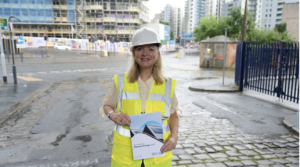Public land: liability or asset?
 As councils come under pressure to divest their woodlands, parks and green spaces, we need a radical rethink of how we manage land, argues Mark Walton from Shared Assets.
As councils come under pressure to divest their woodlands, parks and green spaces, we need a radical rethink of how we manage land, argues Mark Walton from Shared Assets.
Questions of who owns and controls land are woven deep into our history. However, with the notable exception of Scotland, there has been relatively little recent public debate regarding the ownership and control of our natural assets. Now, constraints on public finances and the retrenchment of the state, both locally and nationally, are beginning to bring issues of land ownership back onto the public agenda. Public authorities are reviewing their asset holdings and considering how they can divest themselves of some of their responsibilities for the management of land-based public assets such as woodlands, parks and green spaces. The protests over proposals to sell off parts of the public forest estate demonstrate that there is strong belief among the general public that some assets should remain publicly owned.
While authorities are seeking new approaches to the management of their environmental assets, many communities would like greater control over how their local environment is managed. There is a growing interest in activities such as food growing, generation of renewable energy, woodfuel production and outdoor educational and health services, all of which require access to land.
There is the potential for a radical rethink in how we manage our environmental assets as 21st century commons, using social enterprise approaches to create economic and social benefits while improving the quality of local environments. To do so will require the engagement of regeneration professionals, communities and social enterprises who may not usually consider themselves to have an interest in environmental quality and ‘green’ issues. It may also mean groups and individuals who currently take a volunteer and conservation led approach to environmental improvement developing enterprising approaches that add social and economic value through their work. It is not an easy route and the examples I set out below have all encountered difficulties, but the benefits of community management of land are being realised through new jobs and training opportunities for locals, education for a wide range of audiences, and access to local food, as well as all the wellbeing and health benefits of a natural environment.
So what is the potential for communities to take more active control of their local woodlands and green spaces and to manage them in ways that deliver social and economic benefits? Can this be achieved whilst improving the quality of the local environment and reducing the cost to the public purse?
ENTERPRISING AND COLLABORATIVE APPROACHES TO LAND MANAGEMENT
There are growing numbers of community organisations developing enterprising approaches to the management of their local green spaces. Four case study examples form part of an ongoing research project for the Clore Social Leadership Fellowship which will be published in July. The Woodland Social Enterprise network is getting off the ground.
In some cases, such as Neroche Woodlanders (see case study), the process is being driven by a local community enterprise, which is helping open up the land to new users and uses. In others it is the landowner who has taken the lead. Wycombe District Council is currently in the process of spinning out its woodland services team as a new social enterprise, Chiltern Rangers CIC. The company will begin with a five year contract to manage fourteen sites for the district and will be looking to expand its services. In delivering its conservation and woodland management services, it will be working with adults with learning difficulties and establishing an apprenticeship scheme.
It is not only woodlands, and not only public landowners, where communities are delivering social and economic benefits by taking on the management of undermanaged assets.
London Wildlife Trust has leased a small (1.5 ha) piece of land from Thames Water next to two reservoirs in Hackney. Working with local schools and volunteers it has created a community garden containing a range of different habitats in this densely populated and deprived area of the capital. As well as using the site as a base to deliver education, training, community engagement and environmental improvement projects, the Trust has also developed its relationship with the landowner. Working in partnership with Thames Water, a local housing developer and Hackney Council, the Trust has secured Heritage Lottery funding to begin work to open up public access to these valuable wildlife and recreational spaces as part of the wider regeneration of the area. Building on the success of this partnership the Trust is also working with Thames Water on plans to open up other reservoirs in the city to enable much greater public access, while delivering educational, wildlife, employment and wellbeing benefits. As well as improving the quality and accessibility of the land it owns around its reservoirs, working in partnership enables Thames Water to engage a wider audience with messages relating to water safety and conservation than it would otherwise reach through more traditional means.
In Devon, Broadclyst Community Farm has been established as an Industrial and Provident Society to provide locally-grown food, as well as education and training opportunities, to the local community. Broadclyst is leasing farm land belonging to the National Trust, part of the Killerton Estate just outside Exeter. The Trust could have simply leased the farm commercially as it does with many others on the estate. On this occasion it opted to try a different approach which enables it to achieve its objectives to improve the quality of the farmland while engaging new audiences and supporting the development of a local food economy.
Collaborative management and governance of environmental assets can clearly deliver mutual benefits for communities and landowners and make a positive contribution to local regeneration. However, while many local authorities currently engage with volunteer led community groups on some aspects of their green spaces, there are far fewer examples of collaboration with social enterprises to bring such spaces into productive management.
WHY AREN’T LOCAL AUTHORITIES REALISING THE SOCIAL AND ECONOMIC POTENTIAL OF LAND?
In Shared Assets’ recent survey of 109 English local authorities, almost half of local authorities had involved community groups in the management of their woodlands. However the degree of involvement varied considerably, from consultative (carrying out work led by the local authority) to collaborative (partnering the with local authority and sharing some decisions) to empowered (with devolved responsibility for the management of the woodland through a lease or licence). Far fewer authorities indicated that social enterprises were operating on their woodlands, earning income from producing timber or other woodland products or delivering environmental education or other health related activities.
While local authority managers could see a range of benefits of community management of their woodlands, these mainly focussed on greater community engagement and the potential to attract external funding. Far fewer saw the potential for improved quality of management, entrepreneurial approaches or local economic development.
The time taken to develop partnerships and the lack of capacity to deal with community groups was one of the key concerns among local authority officers, along with a perceived increased risk of poor management. Other concerns included loss of control, reputational risk and legal barriers.
In each of the cases outlined above the landowner retains a substantial degree of control, usually not only through a lease but through a shared management plan. The plan includes agreed outcomes that will result in an improvement in the quality of site. The key to social enterprise management is that it actively seeks to deliver additional social and economic benefits while delivering the agreed management plan.
Such approaches do not require a change in ownership, whether the current owner is a public, private or charitable organisation.
The scale and nature of the social and economic benefits delivered will vary depending on the focus of the group, the nature of the asset and the needs of the local community. However, by productively managing environmental assets to meet local needs, community management can also reconnect people with their environment in a meaningful way, making it relevant to people’s everyday lives.
A key barrier reported by local authority officers when considering greater community involvement in the management of woodlands is the time required to develop relationships and the lack of capacity to deal with community groups. Officers responsible for green space and woodland management are often spread across a number of different departments including leisure, community, environment, planning and neighbourhoods, and in many cases their roles include a range of other responsibilities.
Viewing these spaces not as liabilities, but as assets that contribute to the delivery of sustainable local economic development, might ensure that more resources and a clearer focus were brought to bear on their management.
Tighter budgets and escalating social need means that public authorities and others responsible for the maintenance of environmental assets are uncertain how they will maintain current levels of management. The social, health and wellbeing benefits of well maintained green spaces, and the uplift they provide to local property and business values, are well reported. However their role as economic assets, places to provide work, training and public services, and as sources of renewable resources for local sustainable development, are under explored and under developed.
It was not so long ago that councils viewed their woodlands and green spaces as assets rather than liabilities to be managed, and that ‘the commons’ was part of our language. Traditionally ‘commons’ were areas of land and water, usually in private ownership, which the public had the right to use in order to meet basic needs for food and fuel. Few people today are clamouring for their historic rights to graze livestock or cut turf for fuel. However the principle of shared use and management, based on a mutual interest and irrespective of ownership, is one that could be adapted to meet current needs.
A ’21st century commons’ would see undermanaged land owned by public, private or charitable organisations, opened up to enable productive, sustainable management by enterprising local communities. The landowner can ensure the land is managed in ways that maintain public access and replenish the environment, while the creativity and entrepreneurialism of local people can find new uses that deliver social, economic and environmental benefits to the local area. Such shared approaches will need new frameworks of management and governance, and a willingness from all sides to collaborate, take risks and share control. They offer the potential to open up new resources to support the development of sustainable local economies and improved local environments.
Mark Walton is executive director of Shared Assets which, supported by the Tudor Trust, is developing a programme of support for enterprising community organisations wishing to take on management of local environmental assets. The programme will be launched at a joint event with New Start in September – watch this space for details.
How to… manage land-based assets collaboratively
- Too often land based assets are regarded as liabilities, or managed only for conservation or access purposes. The potential for their productive use is frequently overlooked.
- It is estimated that half of our woodlands are undermanaged, resulting in poor quality habitats and reduced biodiversity. Active management has the potential to produce renewable resources such as woodfuel, hydro or wind power. It can create jobs, training and opportunities to engage vulnerable and excluded children in educational activities, and provide services and activities for people with physical and mental health problems.
- When considering collaborative or shared approaches to land based management, landowners and community and social enterprise groups should follow some basic ground rules of good collaboration.
- It is important to identify shared objectives and complimentary strengths. Limitations on the use the land, due to e.g. legal responsibilities, access requirements or habitat designations, should be communicated clearly and early. Both sides should also be realistic about what is possible, and respect the limitations of other parties.
- An agreed management plan with clear identification of responsibilities, risks, contingencies and liabilities will enable all parties to be clear about the expectations of them. This can be particularly important when personnel change and new staff are not aware of the full history of previous negotiations.
- A social enterprise taking on the management of a piece of land may well require a secure lease, long term management agreement, or an agreed contract to deliver services, in order to secure other funding. Crucially income earned from activities undertaken on the asset must be able to be returned and reinvested in it. Even the most entrepreneurial local manager has little incentive to develop new income streams if the benefits are swallowed up into the central budget of a larger organisation.
- Perhaps the most important aspect of developing a shared approach to land management is patience. The development of collaborative management can take time. Different partners often work in very different ways and with different capabilities and expectations. The benefits however can be remarkable, breathing new life into undermanaged spaces and opening up new sustainable resources for enterprising local communities.
Case Study: Neroche Woodlanders: ‘We want this to be a collaborative arrangement.’
 Neroche Woodlanders is an Industrial and Provident Society established for the benefit of the community. It arose from the Neroche Landscape Partnership Scheme, funded by the Heritage Lottery Fund between 2006 and 2011 and is currently negotiating a management agreement with the Forestry Commission to manage around 40 hectares of public forest around Young Wood, part of the Neroche forest estate in the Blackdown Hills near Taunton in Somerset. The forest is a mixture of plantation and ancient woodland, and is held by the Commission on a 99 year lease from the Crown Estate.
Neroche Woodlanders is an Industrial and Provident Society established for the benefit of the community. It arose from the Neroche Landscape Partnership Scheme, funded by the Heritage Lottery Fund between 2006 and 2011 and is currently negotiating a management agreement with the Forestry Commission to manage around 40 hectares of public forest around Young Wood, part of the Neroche forest estate in the Blackdown Hills near Taunton in Somerset. The forest is a mixture of plantation and ancient woodland, and is held by the Commission on a 99 year lease from the Crown Estate.
Under current legislation the Forestry Commission in England is unable fully to delegate management and tenure of its woodlands to third parties. It is therefore unable to provide a full sublease on the land to Neroche Woodlanders. The proposed management agreement will provide a ‘lease of rights’, enabling elements of forest management to be undertaken by a third party. Public liability and public safety remain a responsibility of the Forestry Commission, though Neroche Woodlanders will carry its own insurance and operate to high standards approved by the Commission.
By bringing together a range of forestry and education skills Neroche Woodlanders aims to create a viable social enterprise delivering a range of activities on the site. Its core objective is to marry together the management of the forest with the use of that forest as a place for training and wellbeing activities. Those activities will be financed through external grants and local service contracts, while forest management will generate timber and woodfuel to supplement income. Volunteering will be a central part of the mix, both for social benefit and to help make the enterprise viable. Complementary activities including corporate team building will contribute to supporting paid staff.
This business model will allow a more intensive use of the site by a wider range of audiences than could be delivered conventionally by the Forestry Commission alone. A Forest Schools project takes place in the woods, helping schoolchildren learn about their natural environment and a Digital Trail guide helps users explore the landscape as they walk through it.
By operating as a self-contained enterprise the organisation can invest any surpluses back into the business and thence into the woodland.
For Gavin Saunders, a founding director of Neroche Woodlanders, the fact that this is public land is important. ‘I wouldn’t want this to be ours – our own private woodland. We want this to be a collaborative arrangement. This is public land, it’s still part of the Forestry Commission public forest estate, but we can realise the Forestry Commission’s objectives for this forest more fully by acting together. In the process we believe we can also explore more effective ways for local people to feel that ‘their’ public forest really is their own’.
- You can find out more about Neroche Woodlanders at: www.youngwood.org.uk


















We believe woodland and green spaces are VITAL assets to every community. Many organisations such as ours use the outdoors as a vital component in programmes to address real social problems by allowing young people to connect to nature in a healing way. Green spaces and woodland should be passed into the voluntary sector, with some very strict criteria around level of conservation effort / upkeep requirements. There may also need to be some grown up conversations about what can and cannot be built on such areas to allow the organisations to use them effectively.
If anyone would be interested in passing 100 acres of woodland out way, then we’d be very grateful! We’re looking for a new home!